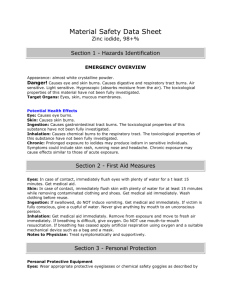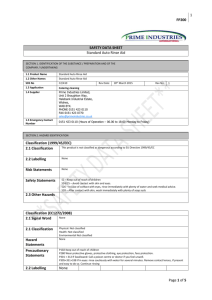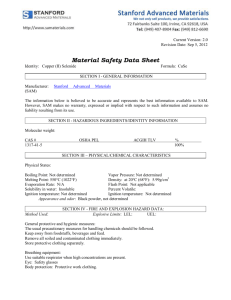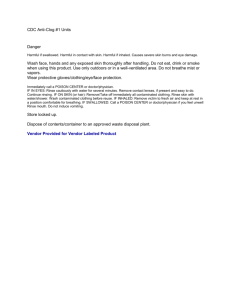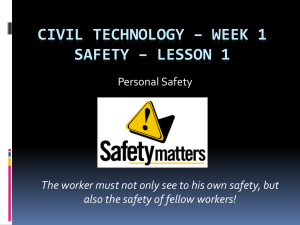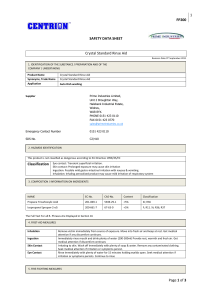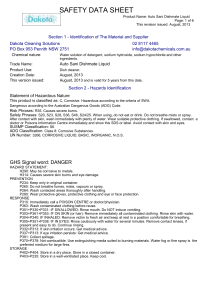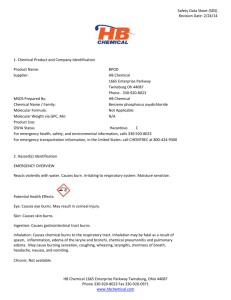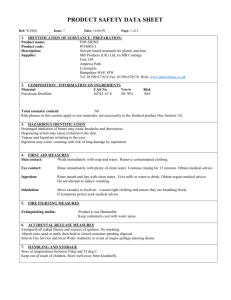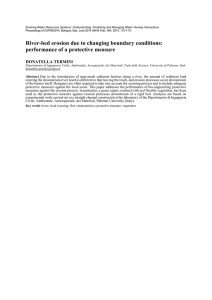FP197 - CS Catering Equipment
advertisement
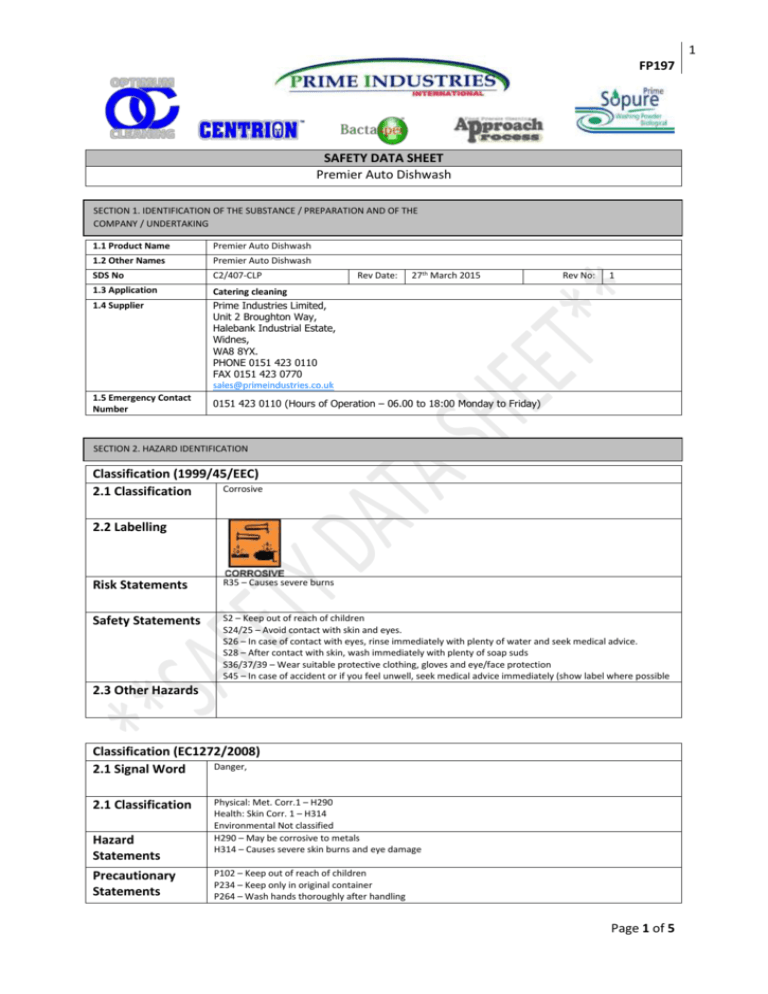
1 FP197 SAFETY DATA SHEET Premier Auto Dishwash SECTION 1. IDENTIFICATION OF THE SUBSTANCE / PREPARATION AND OF THE COMPANY / UNDERTAKING 1.1 Product Name Premier Auto Dishwash 1.2 Other Names Premier Auto Dishwash SDS No C2/407-CLP 1.3 Application Catering cleaning 1.4 Supplier Prime Industries Limited, Unit 2 Broughton Way, Halebank Industrial Estate, Widnes, WA8 8YX. PHONE 0151 423 0110 FAX 0151 423 0770 sales@primeindustries.co.uk 1.5 Emergency Contact Number 0151 423 0110 (Hours of Operation – 06.00 to 18:00 Monday to Friday) Rev Date: 27th March 2015 Rev No: 1 SECTION 2. HAZARD IDENTIFICATION Classification (1999/45/EEC) Corrosive 2.1 Classification 2.2 Labelling Risk Statements R35 – Causes severe burns Safety Statements S2 – Keep out of reach of children S24/25 – Avoid contact with skin and eyes. S26 – In case of contact with eyes, rinse immediately with plenty of water and seek medical advice. S28 – After contact with skin, wash immediately with plenty of soap suds S36/37/39 – Wear suitable protective clothing, gloves and eye/face protection S45 – In case of accident or if you feel unwell, seek medical advice immediately (show label where possible 2.3 Other Hazards Classification (EC1272/2008) Danger, 2.1 Signal Word 2.1 Classification Hazard Statements Precautionary Statements Physical: Met. Corr.1 – H290 Health: Skin Corr. 1 – H314 Environmental Not classified H290 – May be corrosive to metals H314 – Causes severe skin burns and eye damage P102 – Keep out of reach of children P234 – Keep only in original container P264 – Wash hands thoroughly after handling Page 1 of 5 2 FP197 P280 – Wear protective gloves, protective clothing, eye protection face protection P305+351+338 If in eyes: rinse cautiously with water for several minutes. Remove contact lenses, if present and easy to do so. Continue rinsing 2.2 Labelling GHS05 2.3 Other Hazards SECTION 3. COMPOSITION / INFORMATION ON INGREDIENTS 3.2 Mixture Product EC (EINECS No. CAS-No. % Sodium Hydroxide Solution 215-185-5 1310-73-2 10-20 Classification (EC 1272/2008) Classification (67/548/EEC) Physical: Met. Corr.1 – H290. Health: Skin Corr1A – H314. Environmental: Not Classified. C; R35 Product EC (EINECS No. CAS-No. % Tetrasodium Ethylene Diamine Tetraacetate 200-573-9 64-02-8 <5 Classification (EC 1272/2008) Classification (67/548/EEC) Physical: Not Classified. Xn; R20/22 Health: Acute Tox.4 - H302, Acute Tox.4 – H332, Eye Dam.1 – H318 Xi; R38, R41 Environmental: Not Classified. For the full text of the R-phrases mentioned in this section, see section 16. For the full text of the H-statements mentioned in this section, see section 16. SECTION 4. FIRST-AID MEASURES 4.1 Description of First Aid Measures Inhalation Move exposed person to fresh air. Get medical attention Ingestion Get medical advice immediately! Do Not Induce Vomiting! Immediately rinse mouth and drink plenty of water Skin Contact Remove contaminated clothing immediately and wash with soap and water. Get medical attention immediately Immediately flush with plenty of water for up to 15 minutes. Remove contact lenses if safe and easy to do so, open eyes wide apart. Get medical attention immediately. Continue to rinse. 4.2 Most Important Symptoms and effects, both acute and delayed Eye Contact General Information Symptoms described are dependent upon the concentration and exposure time Inhalation Possible irritation of throat, nose & airway Ingestion Irritation, possible burns to throat mouth and stomach Skin Contact Possible chemical burns to skin Eye Contact Possible serious eye damage 4.3 Indication of immediate medical attention and special treatment needed if necessary SECTION 5. FIRE-FIGHTING MEASURES 5.1 Suitable Extinguishing Media Use: The preparation is not readily flammable, use fire-extinguishing media suitable for surrounding materials 5.2 Specific Hazard arising from the chemical When heated in the case of fire, harmful or toxic gases may be produced 5.3 Special protective actions for fire fighters Page 2 of 5 3 FP197 Self contained breathing apparatus and full protective clothing must be worn SECTION 6. ACCIDENTAL RELEASE MEASURES 6.1 Personal Precautions, protective equipment and emergency procedures a. The wearing of suitable protective equipment (including personal protective equipment, see section 8 of this SDS) to prevent any contamination of skin, eyes and personal clothing. b. Follow precautions for safe handling described in section 7 of this SDS. 6.2 Environmental Precautions Spillages of uncontrolled discharges into watercourses must be Immediately alerted to the Environmental Agency or other appropriate regulatory body, without endangering individuals every effort should be made to prevent entrance to drains. 6.3 Methods and material for containment and clean up Drains should be Bunded or capped to prevent entrance or damage. Ventilate well. Dilute with copious amounts of water. Collect with absorbent, non-combustible material into suitable containers. Flush area with plenty of water. SECTION 7. HANDLING AND STORAGE 7.1 Precautions for safe handling Avoid Spilling, skin and eye contact. Do Not Smoke In Work Area! Wash at the end of each work shift and before eating, smoking and using the toilet. Wash promptly if skin becomes contaminated. Promptly remove any clothing that becomes contaminated. When using, do not eat, drink or smoke. 7.2 Conditions for safe Storage, including incompatibilities Keep in original containers. Do not allow product to freeze, avoid extreme temperatures 7.3 Specific end use(s) The identified use for this product is detailed in section 1.2. SECTION 8. EXPOSURE CONTROLS / PERSONAL PROTECTION 8.1 Control parameters Name STD Sodium Hydroxide 35% WEL TWA – 8 Hrs STEL – 15 Min Notes 2 WEL= Workplace Exposure Limit 8.2 Appropriate engineering controls Provide adequate ventilation 8.3 Individual protection measures, such as personal protective equipment (PPE) Respiratory Equipment If ventilation is in sufficient, suitable respiratory protection must be provided. Hand Protection PVC gloves are recommended. Eye Protection Ware approved safety goggles/ Face protection. Other Protection Wear rubber apron, ware rubber footwear. Protective Equipment SECTION 9. PHYSICAL AND CHEMICAL PROPERTIES 9.1 Information on basic physical and chemical properties This Product is a Mixture Appearance Liquid Colour Straw / Yellow Odour Low Solubility Soluble in water pH value >12 Relative Density 1.2 Boiling Point (°C) >100 9.2 Other information Page 3 of 5 4 FP197 SECTION 10. STABILITY AND REACTIVITY 10.1 Reactivity None known 10.2 Chemical stability Stable under normal conditions and use. 10.3 Possibility of hazardous reactions None known 10.4 Conditions to avoid Avoid excessive heat for prolonged periods of time. Do Not allow to freeze 10.5 Incompatible materials Strong Acids. Other halogenated organics 10.6 Hazardous decomposition products Not determined SECTION 11. TOXICOLOGICAL INFORMATION 11.1 Information on toxicological effects Toxicological information We have not carried out any animal testing; therefore we have no toxicological data specifically for this product. The toxicological data, where provided by the raw material manufacture, can be made available on request. SECTION 12. ECOLOGICAL INFORMATION 12.1 Toxicity We have not carried out any Aquatic testing; therefore we have no Aquatic Toxicity Data specifically for this product. The Aquatic Toxicity data, where provided by the raw material manufacturer for the ingredients with aquatic toxicity can be provided on request 12.2 Persistence and degradability Degradability: this product is expected to be biodegradable 12.3 Bioaccumulative potential This preparation does not contain any substance that is expected to be bioaccumlating 12.4 Mobility in soil The product is soluble in water 12.5 Results of PBT and vPvB This preparation does not contain and PBT or vPvB substances 12.6 Other adverse effects Not Known SECTION 13. DISPOSAL CONSIDERATIONS 13.1 Waste treatment methods The preparation is designed for disposal via foul drain after use. Large volumes to be treated as controlled waste. Disposal to licensed waste disposal site in accordance with local waste disposal authority. Clean used container and recycle. SECTION 14. TRANSPORT INFORMATION ADR 14.1 UN Number 1719 14.2 UN Proper shipping name Caustic Alkali Liquid N.O.S. 14.3 Transport hazard Class (es) Class 8 Label 14.4 Packing Group III IMDG ICAO 1719 1719 Caustic Alkali Liquid N.O.S. Caustic Alkali Liquid N.O.S. Class 8 Class 8 III III Page 4 of 5 5 FP197 14.5 Environmental hazards No No 14.6 Special precautions for user (Tunnel Restriction) EAC, HIN, EMS (E) 2P, 80, F-A , S-B 14.7 Transport in bulk according to Annex II of MARPOL73/78 and the IBC Code Not relevant for this product No SECTION 15. REGULATORY INFORMATION 15.1 Safety, health and environmental regulations/legislation specific to the substance or mixture Guidance notes: Workplace Exposure Limits EH40 EU Legislation: Safety Data sheets prepared in accordance with REACH Commission Regulation (EU) No 453/2010 and CHIP Directive 1999/45/EEC Classification, Packaging & Labelling of dangerous preparations. Ingredients are listed with classification under both CHIP – Directive 67/548/EEC and GHS / CLP – Regulation (EC) No 1272/2008 classification, ADR 2013 15.2 Chemical Safety Assessment Not applicable this product is a mixture SECTION 16. OTHER INFORMATION REV. No. REPL. SDS Generated SDS No. SDS Status Approved Notes Risk phrases in full Hazard statements in full Supplementary P- Statements Continued 1/0 27th March 2015 C2/407-CLP Ok Yes This information relates only to the specific material designed and may not be valid for such material used in combination with any other materials or in any process. Such information is to the best of the company’s knowledge and belief, accurate and reliable as of date indicated. However, no warranty, guarantee or representation is made as to its accuracy, reliability or completeness. It is the user’s responsibility to satisfy himself as to the suitability of such information for his own particular use. R20/22 – Harmful by inhalation and if swallowed R35 – Causes severe burns R38 – Irritating to skin R41 – Risk of serious eye damage H290 – May be corrosive to metals H302 – Harmful if swallowed H314 – Causes severe skin burns and eye damage H318 – Causes serious eye damage H332 – May be harmful if swallowed P301+P330+331 – IF SWALLOWED: Rinse mouth. Do NOT induce vomiting P303+P361+P353 – IF ON SKIN: Remove / Take off immediately all contaminated clothing. Rinse skin with water / shower P363 – Wash contaminated clothing before reuse P304+P340 – IF INHALED: Remove victim to fresh air and keep at rest in a position comfortable for breathing P310 – Immediately call a poison centre or doctor / physician P405 – Store locked up END of SDS Page 5 of 5
